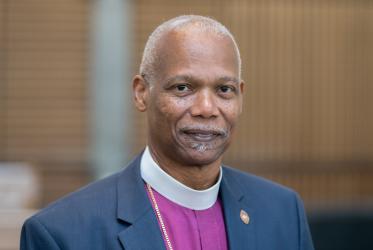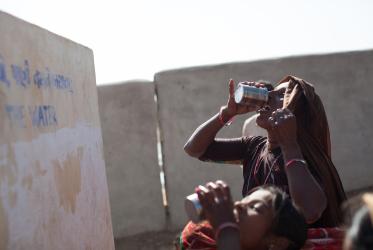Text:
To the thirsty I will give water without cost from the spring of the water of life.
(Revelation 21:6)
Reflection:
In the 1970s a very important essay for our American continent appeared: “Open veins of Latin America”[1]. Its author, Uruguayan writer Juan José Galeano, offers a critical overview of the situation in the subcontinent formed by Latin America and the Caribbean, from the time of its colonization until the 20th century. At that time, the problem was mainly focused on the endemic poverty affecting vast sectors of society that were deeply marginalized due to unemployment, social injustice and famine. Today we would bluntly add “thirst”, or the implications of not having the infrastructure necessary for basic services, amongst them water and the healthy environment that it provides when it is well distributed, or at least not polluted. At that time, the topic of water was barely mentioned in governmental agendas, whereas today it is considered an inalienable right, given that, without it, the food and health chains would be seriously compromised. As well as an abundance of food (for example, Argentina produces food to feed ten times its population[2]), there is also an abundance of water, and yet, there are sectors of society who barely have the minimum amount necessary to feed themselves in a healthy way, and do not have water networks or sewage. Cities are worst affected, and there are large social sectors that lack these basic services.
In the Bible, Genesis tells us about the origin of the world, and water appears as a constituent element of creation and it is used as a metaphor, teaching and parable to communicate the best and worst consequences of its actions. Nevertheless, it is described in many ways that revolve around its positive aspects. That water which appears from the start is not only found in seas, rivers and lakes, but also, abundantly, in aquifers. Part of the earth is floating on top of immense seas of underground fresh water.
The new millennium opened with a renewed reflection around the issue of taking care of God's creation. This involved not only the traditional criticisms relating to the ozone layer depletion in the sky (in Genesis 7 referred to as the waters above), but also the waters below (seas, rivers, etc.), and the water further below, which refers to the underground. A mythical place that seems more suited to referring to evil than to the water that creates springs and gives life. New forms of making theology emerge too, and among them is eco-theology, a discipline that reflects theologically on the environmental crisis and designs environmental management programs to promote a culture of sustainability that addresses the relationships between human beings, nature and God. There are two aspects to this: on the one hand, what human beings take from the earth, such as food production carried out in a natural way and without agrochemicals, but it also denounces the unrestricted and harmful use of nature for purely economic purposes. It also alerts us to the fact that we must not only take care of what we see on the surface, but also of what lies at the bottom of the earth, and that is why it is imperative that we control what is thrown to the ground, from pesticides, to garbage dumps to waste and polluted waters. That is why all water that flows for our use must have a clear objective and processing method in order to avoid pollution.
The church pays attention to human actions and gives a prophetic and also hopeful account of its responsibility as a witness to the promise of life- and not only eschatological life- over death. That is why all of life-giving nature, and especially water, is present as a concern to address in its agenda. Decades of constant reflection on caring for nature have provided us with practical and theological elements to form the basis of care for future generations. This is an important responsibility for us in the places in which we live, not just as citizens, but also as Christians.
Anyone visiting the extensive Latin American territories will also be able to see the immense pampas, the surfaces covered by vegetation, jungles, eternal snow, immense waterfalls and rivers, so long and wide that measuring them is almost impossible. As well as the value of the water wealth lying on the surface, our subsoils are covered with abundant water, an element that is vital for life. Caring for it and preserving it is essential, as well as protecting it from pollution and from any conflict that ownership of water might give rise to.
Latin America has several aquifers, but one of them is amongst the largest in the world. This is the Guarani[3] aquifer, whose name honours the native people who live in those lands: the Guarani, who were able to live in harmony with their rivers and their jungle until colonization began to modify and even destroy that age-old ecosystem.
The Evangelical Church of Río de la Plata, in line with the Church of Germany (EKD), has an annual theme for 2018 which is based on Revelation 21:6: this part of the text which, already in its first verse, tells of the disappearance of the sea and the extinction of water on the surface of the earth. The story continues with other related terms such as the tears produced by the pain and despair. Nevertheless, it ends with the promise of living water, the water that quenches the thirst of the world. Beyond the obvious exegetical interpretation with this water representing the path to the life given by Jesus, it is clear that it also refers to that real and pure water without which physical life would not be possible. The metaphors and symbolisms can lead to profound reflections and, in an apocalyptic context, their significance is amplified, revealing that there is only one clean, clear and healing water. A hopeful dynamic exists, despite the disappearance of surface waters and despite our tears, because there are spring waters that bring us the hope that life might be possible, and that water can come from rocks.
In our Latin America and the Caribbean, full of large cities, we cannot help but wonder whether we might need more specific and not just declamatory urbanization policies, which in turn require a clear plan for the distribution of water and sewage. The great challenge that current governments face is taking water to the most vulnerable sectors and continuing to build a culture of water care, given that water takes care of us and heals the body and the spirit.
May those open veins so dramatically mentioned by Galeano, be transformed into open water taps that make life possible for many in this part of the planet. May the vital element move within those taps around the entire world, and when it gets back to earth, may we return it as our native peoples used to do it, with respect, caring for it, fearing it sometimes for its overwhelming force when it is out of control, but knowing that it was always faithful to mankind and provided fertility to its “Pachamama", its mother earth that feeds mankind after being watered with clean water, with the water of life.
Questions:
- Poverty pays a high price for water and also for health. What are the most appropriate policies to prevent this social injustice?
- Why is there fear of militarization and even wars surrounding water reservoirs?
- Where can we find ethical paradigms for the preservation of nature and of water as a basic good?
[1] https://cienciaconciencia.org.ve/descarga-el-libro-de-eduardo-galeano-l…




